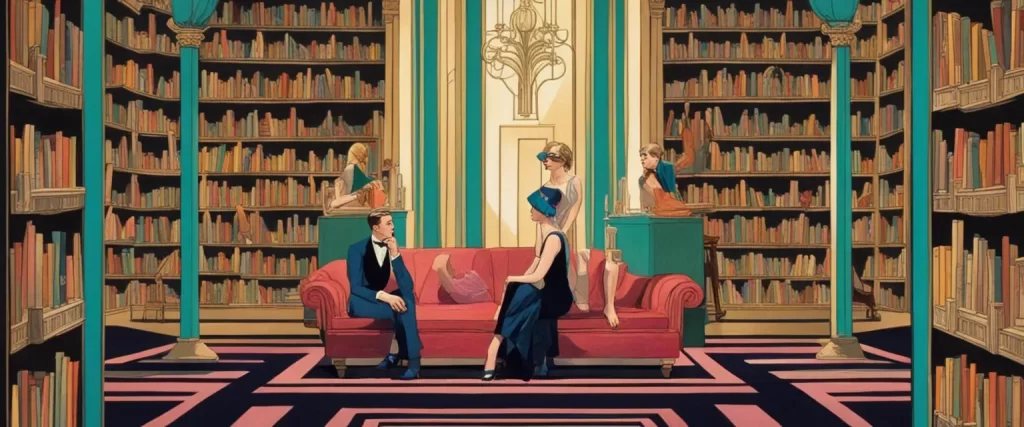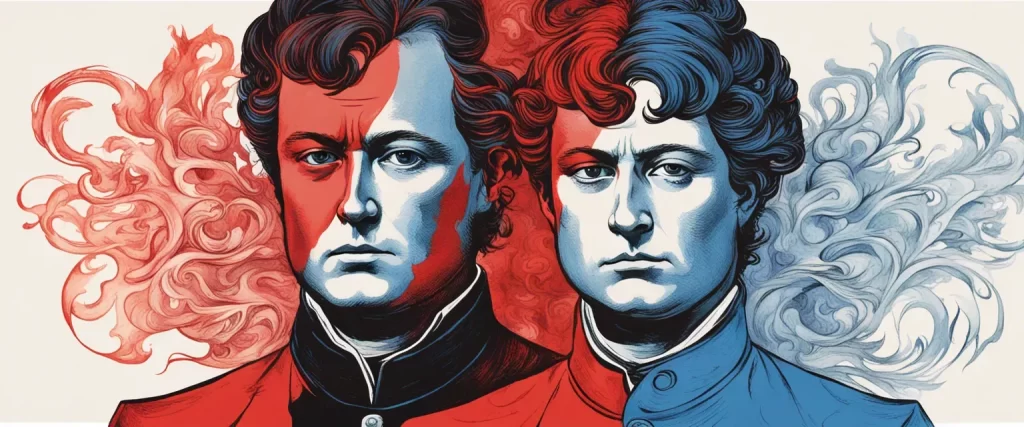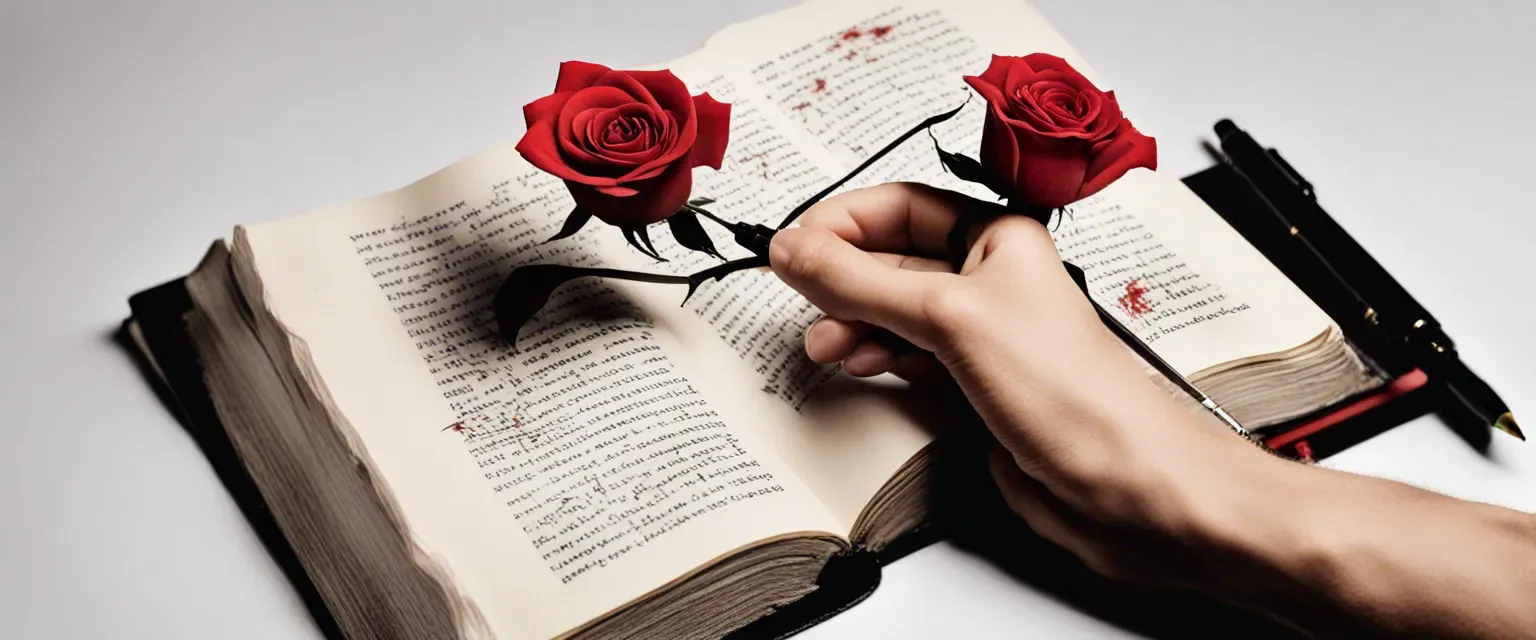——The Red and the Black by Stendhal & The Great Gatsby by F. Scott Fitzgerald
In the vast landscape of literature, certain works stand as shining beacons, captivating readers and forever etching themselves in the annals of literary history. Among these distinguished novels, two remarkable books have garnered immense acclaim and remain beloved by readers across generations: “The Red and the Black” by Stendhal and “The Great Gatsby” by F. Scott Fitzgerald. Although written in different times and contexts, these two masterpieces share a common thread of exploring the human condition and presenting profound insights into the complexities of love, ambition, and societal aspiration.
Published almost a century apart, one in 1830 and the other in 1925, “The Red and the Black” and “The Great Gatsby” depict distinct societies and social classes. Stendhal delves into the rigid hierarchy of post-Napoleonic France, portraying the struggles of Julien Sorel, a young man born into modest circumstances, as he navigates the treacherous waters of love and ambition within a society built on ingrained prejudices. Conversely, Fitzgerald delves into the Roaring Twenties of America, a time of unprecedented prosperity where wealth and indulgence reigned supreme. The Great Gatsby follows Jay Gatsby’s pursuit of Daisy Buchanan, an unattainable love interest, as he traverses societal boundaries and challenges the illusion of the American Dream.
One of the striking aspects of both novels lies in the development of their respective protagonists. Julien Sorel and Jay Gatsby possess compelling similarities beneath the surface, as they both yearn for something more significant than their current circumstances. Sorel’s intellectual prowess and ambition drive him to transcend his lower-class origins, while Gatsby’s relentless pursuit of wealth and social status are fueled by an unquenchable desire to win the heart of his beloved Daisy. Through the lenses of these two protagonists, both Stendhal and Fitzgerald explore the universal themes of personal identity, the allure of social mobility, and the moral compromises made to secure one’s desires.
Another captivating aspect of this comparative study is the role of women in both novels. Stendhal and Fitzgerald present female characters that are not mere objects of desire but possess their own aspirations, complexities, and influence over the male protagonists. Stendhal’s portrayal of Mathilde de La Mole and Fitzgerald’s portrayal of Daisy Buchanan expose the multifaceted nature of femininity and its impact on the choices made by the men in their lives. Understanding the dynamics and motivations of these female characters provides a rich and thought-provoking lens through which to examine the themes of love, power, and societal expectations in both novels.
As we embark on this comparative journey through “The Red and the Black” and “The Great Gatsby,” we delve into two distinct literary worlds, permitting us to explore the human condition through different historical, cultural, and social lenses. From love and ambition to class and societal expectations, these novels offer profound insights into the timeless complexities that have shaped and continue to shape the human experience. Through our examination, we aim to unravel the nuances and uncover the shared thematic threads that make these two works masterpieces, worthy of contemplation and admiration time and again.
Brief Summary of Two Books
The Red and the Black by Stendhal
“The Red and the Black” by Stendhal is a fictional novel set in 19th-century France. It tells the story of Julien Sorel, a young and ambitious peasant who aspires to rise above his lower social status. Julien initially becomes a tutor for the wealthy Rênal family and engages in a passionate affair with Madame de Rênal, the wife of his employer.
As Julien’s desires for success and social advancement grow, he leaves his affair behind and enters into the seminary to pursue a career in the church. However, despite his intelligence and determination, Julien is constantly faced with the hypocritical and corrupt nature of the society he aspires to join. Through his encounters with various influential people, including the liberal Marquis de la Mole and his daughter Mathilde, Julien is torn between maintaining his integrity and using any means necessary to climb the social ladder.
Throughout the book, Stendhal explores themes of love, ambition, social class, and hypocrisy. Through Julien’s character, the novel offers a critical examination of French society and political institutions during the Restoration period. “The Red and the Black” is regarded as a significant contribution to French literature and a precursor to psychological realism.
The Great Gatsby by F. Scott Fitzgerald
The Great Gatsby, written by F. Scott Fitzgerald, follows the intriguing story of Jay Gatsby, a wealthy and enigmatic businessman living in the fictional town of West Egg, Long Island, during the 1920s. The protagonist, Nick Carraway, is the narrator and a young bond salesman who moves to the area, renting a small cottage next to Gatsby’s extravagant mansion.
As the story unfolds, Nick becomes gradually drawn into the glamorous and superficial world of the wealthy elite, with Gatsby at the center of it all. Gatsby is known for throwing lavish parties, hoping to attract the attention of his lost love, Daisy Buchanan, who is married to Tom Buchanan, a wealthy and arrogant man.
Through Nick’s eyes, readers witness the complexities and contradictions of the roaring twenties, including themes such as the American Dream, wealth, love, and the moral decay of society. As Gatsby’s past is slowly revealed, it becomes evident that he has spent years amassing wealth in an attempt to recreate a romantic relationship with Daisy, who he sees as the embodiment of his dreams and desires.
As the story progresses, tension mounts between Gatsby, Tom, and Daisy, resulting in an explosive series of events. The climax of the novel occurs during a confrontation between the various characters, which leads to tragedy and ultimately exposes the dark underbelly of the American Dream.
Fitzgerald’s novel serves as a critique of the hedonistic and materialistic nature of 1920s American society, emphasizing the emptiness and superficiality of the wealthy class’s pursuits. The Great Gatsby explores themes of illusion, reality, the corrupting influence of wealth, unattainable dreams, and the power of love, all set against the backdrop of the Jazz Age.
Comparison between Two Books

Similarities in Fiction Classics
Both The Red and the Black by Stendhal and The Great Gatsby by F. Scott Fitzgerald can be categorized as fiction classics due to several similarities in their writing style and themes.
1. Exploration of class and social mobility: Both novels examine the constraints of social class and the desire for upward mobility. The protagonists of both books, Julien Sorel in The Red and the Black and Jay Gatsby in The Great Gatsby, come from modest backgrounds but aspire to climb the social ladder.
2. Critique of society’s values and morals: Stendhal and Fitzgerald use their novels to comment on the superficiality and corruption of society. They highlight the hypocrisy, materialism, and immorality prevalent in their respective settings – 19th-century France in The Red and the Black and the 1920s Jazz Age in The Great Gatsby.
3. Themes of love and desire: Both novels explore the complex dynamics of romantic relationships and the destructive power of unfulfilled love. Julien and Gatsby are driven by their infatuation with women who represent the unattainable ideals of their respective societies.
4. Examination of the human psyche: Stendhal and Fitzgerald both delve into the psychology of their main characters, examining their hopes, dreams, fears, and motivations. They provide readers with deep insights into the minds of Julien and Gatsby, allowing us to understand their actions and decisions.
5. Use of symbolism and imagery: Both authors employ rich symbolism and vivid imagery to enhance the reading experience. Stendhal and Fitzgerald use recurring symbols and motifs to represent various themes and ideas, adding layers of complexity to their narratives.
6. Narrative structure and writing style: Both novels possess a strong and engaging narrative structure. Stendhal and Fitzgerald utilize descriptive language and a fluid writing style to immerse readers in their respective worlds. They also employ techniques like foreshadowing and irony to create tension and suspense.
Overall, both The Red and the Black and The Great Gatsby share common characteristics of fiction classics, such as their exploration of social class, critique of society, examination of love and desire, portrayal of the human psyche, use of symbolism, and engaging writing style. These elements contribute to their enduring status as timeless works of literature.
Divergences in Fiction Classics
Both The Red and the Black by Stendhal and The Great Gatsby by F. Scott Fitzgerald are considered fiction classics with their own unique qualities and divergences.
One major divergence between these books lies in their settings. The Red and the Black is set in early 19th-century France, specifically during the Bourbon Restoration period, which serves as a backdrop for the social and political commentary within the narrative. On the other hand, The Great Gatsby is set in 1920s America, during the Roaring Twenties, a time of great economic prosperity and cultural decadence known as the Jazz Age. The contrasting settings provide distinct contexts for the exploration of themes such as class, ambition, and the pursuit of the American Dream.
Another significant divergence is the approach to character development. In The Red and the Black, Stendhal meticulously delves into the psychology and internal conflicts of his protagonist, Julien Sorel. The readers are given access to the intricate thought process of Julien, and Stendhal explores his desires, ambitions, and moral struggles with great detail. In contrast, The Great Gatsby focuses more on the externalities of its characters, particularly Jay Gatsby himself. Fitzgerald portrays Gatsby as a mysterious and enigmatic figure, showcasing his lavish parties and flamboyant lifestyle, leaving much of his true inner self open to interpretation and speculation.
Furthermore, the themes explored in these books also diverge. The Red and the Black examines the inherent conflicts between social classes and the limitations that society places upon an individual’s aspirations for upward mobility. Stendhal analyzes the paradoxical nature of love and passion, and its often tragic consequences when entangled with ambition and social expectations. Meanwhile, The Great Gatsby delves into the corrupting influence of wealth and the hollowness of the American Dream. Fitzgerald critiques the materialistic nature of society, illustrating the disillusionment and longings that lie beneath the glamorous façade of the Roaring Twenties.
Lastly, the writing styles of Stendhal and Fitzgerald differ significantly. Stendhal employs a more introspective and philosophical approach, often exploring the internal thoughts and motives of his characters in a stream-of-consciousness manner. In contrast, Fitzgerald’s writing style is known for its lyrical and poetic prose, capturing the splendor and excesses of the Jazz Age through vivid descriptions and acutely observant narration.
In conclusion, while both The Red and the Black and The Great Gatsby are fiction classics, they possess distinctive divergences in terms of setting, character development, themes, and writing style. Stendhal’s work focuses on class struggles and the complexities of human psyche, set in 19th-century France, while Fitzgerald’s novel critiques the American Dream and explores the superficiality of society during the Roaring Twenties in America.

Conclusion
Both The Red and the Black by Stendhal and The Great Gatsby by F. Scott Fitzgerald are considered classic novels and have their own merits. Ultimately, the choice of which book is more worthy of reading will depend on personal preferences and interests.
The Red and the Black is a psychological novel set in early 19th-century France. It explores themes of ambition, love, and society’s hierarchical structure. The protagonist, Julien Sorel, is a young man from a poor family who desires to rise in society through education and manipulation. The novel provides a deep analysis of human nature, social hierarchy, and the complexities of love. Stendhal’s writing style is introspective and elegant, making it a rewarding and intellectually stimulating read.
On the other hand, The Great Gatsby is a classic American novel set in the roaring twenties. It delves into the decadent and materialistic society of the time, examining themes of wealth, love, and the illusion of the American Dream. The story revolves around Jay Gatsby, a mysterious millionaire who throws extravagant parties to win back the love of his life, Daisy Buchanan. Fitzgerald’s writing is lyrical and evocative, capturing the spirit of the Jazz Age and offering a critique of the American society of his time.
In terms of readability, The Great Gatsby may be more accessible to a wider range of readers due to its shorter length and more contemporary writing style. However, The Red and the Black offers a richer and more complex exploration of social dynamics, psychology, and personal ambition.
Ultimately, both novels are masterpieces in their own right and have cultural significance. It is worth considering your personal interests and preferences before making a choice between the two.



